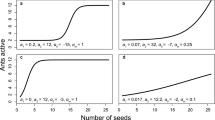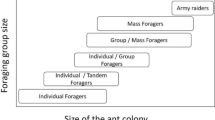Abstract
In this paper, we used the food-correlated search behavior observed in foraging ants returning to a previously rewarding site to study information transfer during recruitment in the ant Lasius niger. We hypothesized that, if information about the characteristics of the food is conveyed during recruitment, food-correlated search tactics should also be observed in recruited workers. Our results show that the characteristics of the trajectories of recruited workers are comparable to those of scout ants returning to a site or prior food find and depend more on the type (prey/sugar) than on the quality (sugar concentration) of the food discovered by the scouts. Independent of sugar concentration, workers recruited to a source of sugar search with a greater sinuosity than workers recruited to a prey. Experimental manipulation of the recruitment signals (chemical trail and contact between ants) shows that the trail pheromone laid down by recruiting ants does not play a role in the modification of trajectory sinuosity. This change appears to be most likely triggered by a direct perception of the residue of sugar smeared on the body of the recruiting workers coming back to the nest.



Similar content being viewed by others
References
Beckers R, Deneubourg JL, Goss S (1993) Modulation of trail laying in the ant Lasius niger (Hymenoptera: Formicidae) and its role in the collective selection of food source. J Insect Behav 6: 751–759
Bell WJ (1990) Searching behavior patterns in insects. Annu Rev Entomol 35:447–467
Bell WJ, Tortorici C, Roggero RJ, Kipp LR, Tobin TR (1985) Sucrose-stimulated searching behaviour of Drosophila melanogaster in a uniform habitat by period of deprivation. Anim Behav 33:436–448
Bonavita-Cougourdan A, Morel L (1984) Les activités antennaires au cours des contacts trophallactiques chez la fourmi Camponotus vagus ont-elles valeur de signal? Insectes Soc 31:113–131
Breed MD, Fewell JH, Moore AJ, Williams KR (1987) Graded recruitment in a ponerine ant. Behav Ecol Sociobiol 20:407–411
Breed MD, Bowden RM, Garry MF, Weicker AL (1996) Giving-up time variation in response to differences in nectar volume and concentration in the giant tropical ant, Paraponera clavata (Hymenoptera: Formicidae). J Insect Behav 9:659–672
Burkhardt JF (1998) Individual flexibility and tempo in the ant, Pheidole dentata, the influence of group size. J Insect Behav 11:493–504
Cammaerts MC (1977) Recrutement d’ouvrières vers une source d’eau pure ou d’eau sucrée chez la fourmi Myrmica rubra L. (Formicidae). Biol Behav 2:287–308
Cammaerts MC, Cammaerts R (1980) Food recruitment strategies of the ants Myrmica sabuleti and Myrmica ruginodis. Behav Process 5:251–270
Cassill DL (2003) Rules of supply and demand regulate recruitment to food in an ant society. Behav Ecol Sociobiol DOI 10.1007/s002650030639
Cassill DL, Tschinkel WR (1999) Task selection by workers of the fire ant Solenopsis invicta. Behav Ecol Sociobiol 45:301–310
Crawford DL, Rissing SW (1983) Regulation of recruitment by individual scouts in Formica oreas. Insectes Soc 30:177–183
Crist TO, MacMahon JA (1991) Individual foraging components of harvester ants: movement patterns and seed patch fidelity. Insectes Soc 38:379–396
De Biseau JC, Pasteels JM (1994) Regulated food recruitment through individual behavior of scouts in the ant, Myrmica sabuleti (Hymenoptera: Formicidae). J Insect Behav 7:767–777
Detrain C, Deneubourg JL (1997) Scavenging by Pheidole pallidula: a key for understanding decision-making systems in ants. Anim Behav 53:537–547
Detrain C, Pasteels JM (1991) Caste differences in behavioral thresholds as a basis for polyethism during food recruitment in the ant, Pheidole pallidula (Nyl.) (Hymenoptera: Myrmicinae). J Insect Behav 4:157–176
Detrain C, Deneubourg JL, Pasteels JM (1999) Decision-making in foraging by social insects. In: Detrain C, Deneubourg JL, Pasteels JM (eds) Information processing in social insects. Birkhäuser, Basel, pp 331–354
Dornhaus A, Chittka L (1999) Evolutionary origins of bee dances. Nature 401:38
Fourcassié V, Traniello JFA (1993) Effects of experience on food-searching behavior in the ant Formica schaufussi (Hymenoptera: Formicidae). J Insect Behav 6:287–299
Fourcassié V, Traniello JFA (1994) Food searching behaviour in the ant Formica schaufussi (Hymenoptera, Formicidae): response of naive foragers to protein and carbohydrate food. Anim Behav 48:69–79
Fourcassié V, Traniello JFA (1995) Ant search behaviour analysis with a video frame grabber. Insectes Soc 42:249–254
Frisch K von (1967) The dance language and orientation of bees. Harvard University Press, Cambridge, Mass
Hangartner W (1969) Structure and variability of the individual odor trail in Solenopsis germinata Fabr. Z Vgl Physiol 62:111–120
Hangartner W (1970) Control of pheromone quantity in odor trails of the ant Acanthomyops interjectus Mayr. Experientia 26:664–665
Harkness RD, Maroudas NG (1985) Central place foraging by an ant (Cataglyphis bicolor)- a model of searching. Anim Behav 33:916–929
Hölldobler B (1999) Multimodal signals in ant communication. J Comp Physiol A 184:129–141
Lenoir A, Jaisson P (1982) Evolution et rôle des communications antennaires chez les insectes sociaux. In: Jaisson P (ed) Social insects in the tropics. Presses de l’Université Paris XIII, Paris, pp 157–180
Mailleux AC, Deneubourg JL, Detrain C (2000) How do ants assess food volume? Anim Behav 59:1061–1069
Mercier JL, Lenoir A (1999) Individual flexibility and choice of foraging strategy in Polyrhachis laboriosa F. Smith (Hymenoptera, Formicidae). Insectes Soc 46:267–272
Michelsen A (1993) The transfer of information in the dance language of honeybees: progress and problems. J Comp Physiol A 173:135–141
Nieh JC (1998) The food recruitment dance of the stingless bee, Mellipona panamica. Behav Ecol Sociobiol 43:133–145
Pasteels JM, Deneubourg JL, Goss S (1987) Self-organization in ant societies. I. Trail recruitment to newly discovered food sources. In: Pasteels JM, Deneubourg JL (eds) From individual to collective behavior in social insects. Birkhäuser, Basel, pp 155–175
Portha S, Deneubourg JL, Detrain C (2002) Self-organized asymmetries in ant foraging: a functional response to food type and colony needs. Behav Ecol 13:776–781
Reznikova Z, Ryabko BY (1996) Transmission of information regarding the quantitative characteristics of an object in ants. Neurosci Behav Physiol 26:397–405
Robson SK, Traniello JFA (1998) Resource assessment, recruitment behavior, and organization of cooperative prey retrieval in the ant Formica schaufussi (Hymenoptera: Formicidae). J Insect Behav 11:1–22
Roces F (1993) Both evaluation of resource quality and speed of recruited leaf-cutting ants (Acromyrmex lundi) depend on their motivational state. Behav Ecol Sociobiol 33:183–189
Roces F (2002) Individual complexity and self-organization in foraging by leaf-cutting ants. Biol Bull 202:306–313
Schmid-Hempel P (1984) Individually different foraging methods in the desert ant Cataglyphis bicolor (Hymenoptera, Formicidae). Behav Ecol Sociobiol 14:263–271
Seeley TD (1998) Thoughts on information and integration in honey bee colonies. Apidologie 29:67–80
Szlep-Fessel R (1970) The regulatory mechanisms in mass foraging and the recruitment of soldiers in Pheidole. Insectes Soc 18:233–244
Torossian C (1973) Etude des communications antennaires chez les Formicoidea: analyse du comportement trophallactique d’échanges alimentaires pratiqués entre ouvrières de la fourmi Dolichoderus quadripunctatus. CR Acad Sci Paris Ser D 227:1381–1384
Traniello JFA (1987) Social and individual responses to environmental factors in ants. In: Deneubourg JL, Pasteels JM (eds) From individual to collective behavior. Birkhauser, Basel, pp 63–80
Traniello JFA (1988) Variation in foraging behavior among workers of the ant Formica schaufussi: ecological correlates of search behavior and the modification of search pattern. In: Jeanne RL (ed) Interindividual behavior variability in social insects. Westview, Boulder, Colo, pp 91–112
Traniello JFA (1989) Foraging strategies of ants. Annu Rev Entomol 34:191–210
Traniello JFA, Fourcassié V, Graham TP (1991) Search behavior and foraging ecology of the ant Formica schaufussi: colony-level and individual patterns. Ethol Ecol Evol 3:35–47
Traniello JFA, Kozol AJ, Fournier MA (1992) Resource-related spatial patterns of search in the ant Formica schaufussi: a field study. Psyche 99:87–93
Völkl W, Woodring J, Fischer M, Lorenz MW, Hoffmann KH (1999) Ant-aphid mutualisms: the impact of honeydew production and honeydew sugar composition on ant preference. Oecologia 118:483–491
White J, Tobin TR, Bell WJ (1984) Local search in the housefly Musca domestica after feeding on sucrose. J Insect Physiol 30:477–487
Wilson EO (1971) The insect societies. Harvard University Press, Cambridge, Mass
Acknowledgements
We would like to thank F. Fayret for technical help, S. Grosset and E. Goldstein for assistance in the experiments, J.C. Biesmeijer for interesting discussions, and R. Jeanson, C. Detrain, R. Bon and Alain Dejean for critically reading the manuscript. Thanks are also due to Andrea Dejean who kindly revised the English. This work was financed in part by Conseil Régional Midi-Pyrénées.
Author information
Authors and Affiliations
Corresponding author
Additional information
Communicated by J. Heinze
Rights and permissions
About this article
Cite this article
Le Breton, J., Fourcassié, V. Information transfer during recruitment in the ant Lasius niger L. (Hymenoptera: Formicidae). Behav Ecol Sociobiol 55, 242–250 (2004). https://doi.org/10.1007/s00265-003-0704-2
Received:
Revised:
Accepted:
Published:
Issue Date:
DOI: https://doi.org/10.1007/s00265-003-0704-2




